Abstract
Recently, work style improvement is one of the important themes in Japanese society. In traditional Japanese sense of values, long working hours have been regarded as a virtue. Recently many companies are becoming recommended to leave on time. Therefore, many offices have some promoting activities to facilitate on time leaving. However, many managers still struggle to let leave workers on time actually. Under such a background, how to support work style improvement using light weight information technology is the big question of this study. Actually, the traditional computerization of previous generation offices often used heavy technologies. But unfortunately, heavy technologies have often been a barrier to adoption, spread, or response to change. In contrast, light weight technologies such as IoT recently shown are expected to improve not only personal life but also work environment. As a first step, this study conducts a questionnaire survey to find out psychological factors that impede on-time leaving. Next, based on results of the first survey, this study proposes Doll-based closing chime system "SADATOKI JIZOU" using speech synthesis technology. This doll automatically speaks some topics that triggers of closing works around the closing time. Such topics provided from the server PC managing several types of information. The results of the experiment at the actual office showed not only the direct effects on on-time leaving but also by-product potentialities such as community activation, conversation promotion, unity improvement, and healing provided.
Keywords: Office, work-style improvement, speech synthesis is technology, community activation
Introduction
Work style improvement is one of the important themes in recent Japanese society (Azizah, Matsumoto, & Naka, 2013). In traditional Japanese sense of values, long working hours have been regarded as a virtue. However, in recent years, many companies are becoming recommended to leave on time (Egawa et al., 2018). There are various reasons for such a change from the viewpoint of management, such as improvement of efficiency, improvement of creativity, health promotion, energy saving, reduction of labour cost and so on. On the other hand, expectations from the worker's individual perspective include improvement of work-life balance, women's social advancement, management of motivation, Contribution to the local community, etc. Under such background, even though many offices have promoting activities such as “No-Overtime-Day” and “Premium-Friday”, many managers still struggle to let leave workers on time actually. When the fixed time comes at work, people feel difficulties leaving the office, in no small measure, without any specific reason. The opposite way around, as the regulation for overtime work gets tighter, people have become extra mindful also to work overtime. In this research, we defined the stress and time caused by the attentions from each other around the fixed time, "unprofitable pent-up feelings of the fixed time". Our previous research (Matsumoto, Iwane, & Naka, 2014) sent out various information using the audio broadcast. It worked well as triggers for communication amongst workers and made the sense of togetherness as a team. Drew from this experience, we developed a system "SADATOKI JIZOU" to reduce the "unprofitable pent-up feelings of the fixed time". In this system, the synthetic voice read out the contents to broadcast at the office, which should trigger workers to switch actions and smoothly sort the workers between the ones who wish to leave and the ones who wish to stay working.
Problem Statement
To understand the current situation of the unprofitable pent-up feelings of the fixed time and use it as a guidance of the system development, we conducted a "consciousness survey about leaving at the fixed time and the overtime work" of 139 workers. There are 11 questions and the questions are divided into three categories: 1) Consciousness of leaving and overtime work, 2) Reasons and excuses to leave, 3) Difficulty leaving and not wanting others to leave (Table 1).
Consciousness of leaving on time and overtime work
36% of workers feel the difficulty leaving the office on time, even when their work is complete (Figure 1). 40% answered that they feel the difficulty staying to work overtime. Overall, people shared the feeling that it is preferred to leave the office on time and the overtime work is undesired.

Reasons and excuses to leave
We divided the answers to the Q2 "Reasons for the difficulty leaving the office" into three (Table 2) and the answers to the Q5 "Reasons for the difficulty staying to work overtime" into five (Table 3). For the reasons for the difficulty leaving, most answered "feel bad for others" and for the reasons for the difficulty staying to work overtime, it was mainly "company's rules and regulations" or "I get asked to leave". It became apparent that the workers feel difficulty leaving or staying the office from their environment.
We analysed the result of Q8 and Q9, "Reasons used in the past to leave the office" and "Convincing reasons to leave the office on time" using the text-mining approach. And we created the list of extracted words that has high appearance frequency. Then referencing to the words that appear frequently and co-occurring network, we predicted the kinds of excuses and named them. We aggregated each kind of excuses by taking out the words that seem to be included in each kind from the list of extracted words and searching by the words from the list of survey result.
Excuses such as "plan with the family or others" and "physical unwellness" are easily acceptable, even "have a plan" can be an acceptable reason as shown in Figure 2. Also, there was an answer saying that the worker prompts to leave the office by encouraging others.
Figure 3 shows the actual daily trigger of the workers. As the trigger to leave the office in the daily life (Q7), the most popular answer was "the work is packed up", followed by "the fixed time".
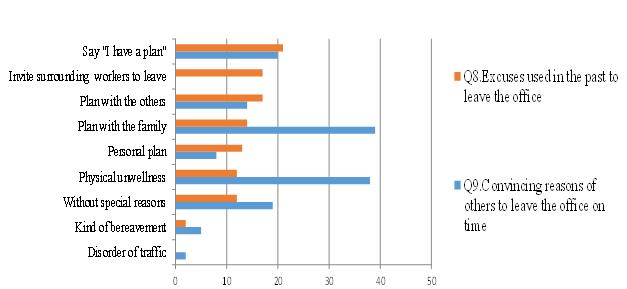
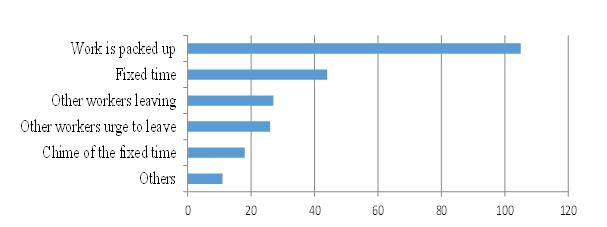
Difficulty leaving and not wanting others to leave
Q10 and Q11 are questions about consciousness (toward seniors/ juniors/ associates) to difficulty leaving and not wanting others to leave (Figure 4). Regarding the difficulty leaving the office (Q10), "feel strongly", and "feel so" was answered most to the seniors, then to juniors, finally to associates. "Feel lightly" and "do not feel so" was answered most to the associates. Close to half of the people feel difficulty leaving earlier than the seniors. Regarding not wanting others to leave (Q11), over half answered "do not feel so". "Feel strongly" and "feel so" was less than 15%. From the result of these two and Q2, the reasons for feeling the difficulty leaving the office are due to feeling bad for others. However, the "others" around are not feeling negative about them leaving, as much as the leaving ones feel. That is to say, here is the perception gap. The possibility of unnecessary care, stress and overwork became apparent due of the ones leaving the office feeling unnecessary difficulty.

Research Questions
Actually, the traditional computerization of previous generation offices often used heavy technology. But unfortunately, many heavy technologies have often been a barrier to adoption or spread. Of course, they also often lead a difficulty to keep up with changes of the business environment. In contrast, light weight technologies such as IoT that have recently emerged are expected not only to improve personal life but also work environment (Dery, Sebastian, & Van der Meulen, 2017). Hence, the big question in this study is:
How to support work style improvement using light weight IT.
Purpose of the Study
As mentioned above, many workers have "unprofitable pent-up feelings of the fixed time". The first purpose of this study is to clarify the actual condition and factors of such “unprofitable pent-up feelings” about leaving the office. Also, the second purpose is to develop a doll-based system using speech synthesis technology and show its effect and possibility. Our past research experiences (Egawa, et al., 2018; Matsumoto, Okada, Kidosaki, Naka, & Yamaguchi, 2011) has brought such a way to do small developments after understanding the reality.
Research Methods
Based on results of above questionnaire survey to find out psychological factors that impede on-time leaving, this study proposes Doll-based closing chime system "SADATOKI JIZOU" using speech synthesis technology. The proposed system consists of a speaker, a doll, a vibrating pedestal with microcomputer, and a smartphone as a control device as shown in Figure 6. Around the closing time, this doll automatically speaks some topics that triggers of closing works. Such topics provided from the server PC managing common Excuse DB, What Day is Today DB, actual worker’s tweets, information about news and weather forecast. Figure 5 shows an overview of the system configuration and data flow.
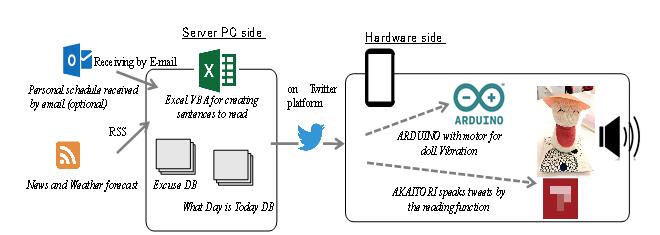
Character setting of doll
As we build up the system, we set Jizou (Ksitigarbha) as the character, familiar for Japanese people and neutral. With this, we named the system "SADATOKI JIZOU".
Creating the Excuse DB and What Day is Today DB
We created the "Excuse database (DB)" from the data of excuses we obtained from the field survey. We extracted 40 excuses that seem to have high general versatility after breaking the high frequent excuse terms down into patterns. In addition to the Excuse DB, we also created "What Day is Today DB" as the static motivator information that has broad utility. This database is a list of memorial days of 366 days, comprised of 602 data.
Framework and development of the system
As seen in Figure 6, we covered the existing motivations to leave the office such as chimes and calls by preparing a wide range of motivating information from ones that have broad utility to ones that fits individual situations. By making the #3 (individual plan) and #4 (general-purpose information), we avoid the overwhelming feeling of when one's plan is particularly called out. The data that is the base of what is read out is loaded using Excel VBA. The combination of #4 data, which is prioritized and #1 - #3 motivating information, randomly picked, are used to create the text and automatically posted on Twitter. For example, "Now is the fixed time. Today is a meat day. The weather forecast from now is cloudy then to rain. Mr. X plans to have dinner with the family tonight." Table 4 shows the examples of 4 types of trigger information. The smartphone inside of the SADATOKI will read out the tweet using the feature from the Twitter client "Akaitori" which has a speech function with speech synthesis technology, and gets broadcasted. Also, we believe in the needs of grabbing attention when reading out. For this, we moved the Jizou puppet using Arduino and motor, which brings out the mind and live feeling (Figure 5).
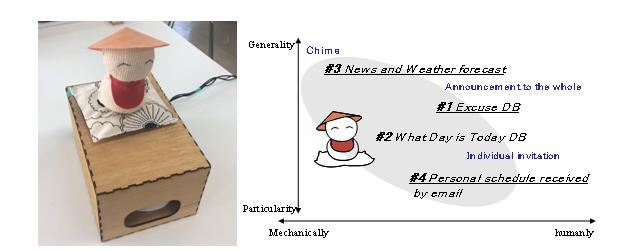
Findings
This study conducted experiments to verify the effectiveness of SADATOKI at the actual office. For 7 days, we broadcasted 5 times a day including the work start time, lunch start time, fixed time, and an hour before and after the fixed time. There were 12 examinees. We held a preliminary survey, extracting the questions from the preliminary study and adding the questions regarding the current work attendance situation (11 questions) followed by the system operation and evaluation survey (25 questions) and a group interview (Table 5). Figure 7 contains the snippet of the evaluation survey result after the operation.
Results of the experiments
- About the character of doll: 92% felt the Jizou character is appropriate and favourable (92%). Reasons being "cute" and "makes the relaxing atmosphere" (Q13, 14).
- Action switch: All people answered that the broadcasting by SADATOKI works as the refreshment trigger (breath-freshener) and 92% answered that it works as the trigger to switch actions. This shows the possibility of SADATOKI reducing the pent-up feelings about time (Q16, 17).
- Communication: 41% answered that conversations about the broadcasted contents occurred within the team, making the office atmosphere better (Q15, 18). At the interview, it became clear that contents that bring questions or guesses such as "What day is today" and "Excuse" triggered many conversations.
- Easiness to leave: 33% answered that SADATOKI made it easier to leave the office. However, there was almost no change regarding the overtime work (Q20, 21). As apparent from the result of the preliminary survey, the examinees this time already had easy leave and work overtime environment, which is a contributory factor to this result.
- Future use: For the Q22 "Do you want to keep using SADATOKI JIZOU?" 83% answered "Yes" with the reasons such as "the time signal provides a good change of the pace" and "the atmosphere softens by bringing conversations sometimes" (Q23). The reasons for "No" included "difficult to concentrate during meetings" (Q24).
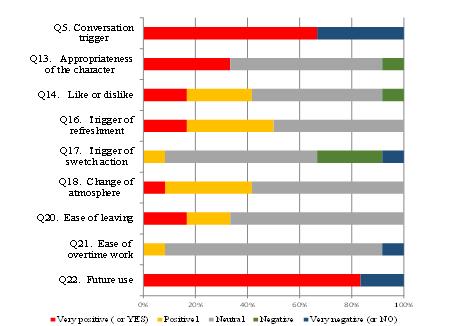
Conclusion
In the first place, the main purpose of the proposed system is not to reduce overtime work directly, but to reduce unnecessary psychological stress of workers when leaving work or continuing work. From this experimental trial, the broadcasting by SADATOKI JIZOU worked as a breath-fresher and the trigger to switch actions, which has the potential to soften the "unprofitable pent-up feelings of the fix time" from the mental side.
Also, it brings out communication amongst the users depending on the contents broadcasted. The JIZOU (Ksitigarbha) character used for this system gives a positive impression to the users and helps users to find interests of the broadcasted contents. The above results are from a small number of subjects (n = 12) using the prototype system.
In the future, it will be necessary to conduct experiments in various cases. Also, some ideas gained from experiment in this study give us many suggestions for enhancing function, contents and stability of our system.
References
Azizah, M. A., Matsumoto, Y., & Naka, R. (2013). A Fundamental study of workplace communication: determinants of the amount of f2f communication and its impact to workplace spatial settings. Proc. of 2013 IEEE Symposium on Business, Engineering and Industrial Applications, 318-323
Dery, K., Sebastian, I. M., & Van der Meulen, N. (2017). The digital workplace is key to digital innovation. MIS Quarterly Executive, 16(2), 135-192
Egawa, I., Kawakita, K., Katagiri, Y., Masuda, A., Ishiyama, N., Yuji, M., …& Naka, R. (2018). Workplace reform with changing management through the user participation workshop: The Case Study of Seiyo City Office. Proc. of the 3rd International Conference on Rebuilding Place (ICRP2018), 190-198.
Matsumoto, Y., Iwane, R., & Naka, R. (2014). A study on feeling the ambience using Speech synthesizer among workers Part1. Summaries of technical papers of annual meeting Architectural Institute of Japan 2014, E-1, 485-486.
Matsumoto, Y., Okada, Y., Kidosaki, N., Naka, R., & Yamaguchi, S. (2011). Memo externalizer: Support environment for bridging from personal idea to group discussion in design meeting. Proc. of the 16th Conference on Computer-Aided Architectural Design Research in Asia (CAADRIA2011), 677-686
Copyright information

This work is licensed under a Creative Commons Attribution-NonCommercial-NoDerivatives 4.0 International License.
About this article
Publication Date
26 December 2017
Article Doi
eBook ISBN
978-1-80296-950-4
Publisher
Future Academy
Volume
2
Print ISBN (optional)
-
Edition Number
1st Edition
Pages
1-882
Subjects
Technology, smart cities, digital construction, industrial revolution 4.0, wellbeing & social resilience, economic resilience, environmental resilience
Cite this article as:
Matsumoto*, Y., Masuda, A., & Naka, R. (2017). A Doll-Based Closing Chime System For Workstyle Improvement In Japanese Workplace. In P. A. J. Wahid, P. I. D. A. Aziz Abdul Samad, P. D. S. Sheikh Ahmad, & A. P. D. P. Pujinda (Eds.), Carving The Future Built Environment: Environmental, Economic And Social Resilience, vol 2. European Proceedings of Multidisciplinary Sciences (pp. 472-480). Future Academy. https://doi.org/10.15405/epms.2019.12.46
